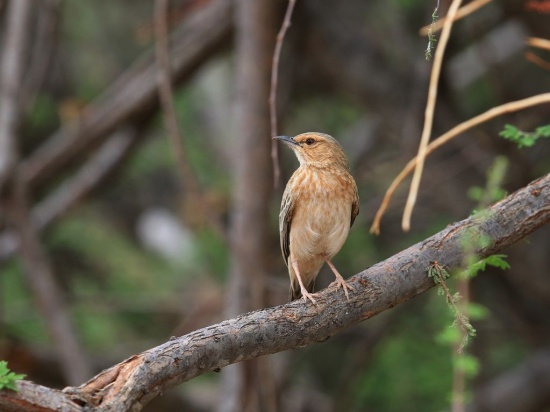(Picture showing front of bird. Al sections now started. References updated. Incomplete gone) |
|||
| (7 intermediate revisions by 5 users not shown) | |||
| Line 1: | Line 1: | ||
| + | [[Image:Pink Breasted Lark.JPG|thumb|550px|right|<br />Photo by {{user|Peter+Merritt|Peter Merritt}}<br />[[Maasai Mara]] Park, [[Kenya]], [[Africa]], 2015]] | ||
| + | ;[[: Category:Calendulauda|Calendulauda]] poecilosterna | ||
| + | ''Mirafra poecilosterna'' | ||
| + | ==Identification== | ||
| + | 15–16 cm (6-6¼ in); a pipit-shaped lark | ||
| + | *Slim bill | ||
| + | *Long tail | ||
| − | + | ====Similar Species==== | |
| − | == | + | Similar in build and habit to the [[Fawn-coloured Lark]] but it lacks the broad white [[Topography#Heads|supercilliary]] stripe and is altogether paler with a noticeably grey crown. |
| − | |||
| − | |||
==Distribution== | ==Distribution== | ||
| − | + | [[Image:090610 Pink-breasted Lark 9530.jpg|thumb|350px|right|Photo by {{user|Glen+Tepke|Glen Tepke}}<br />Samburu National Reserve, [[Kenya]], 10 June 2009]] | |
| + | [[Africa]]: found in savannas from southern [[Ethiopia]] to [[Kenya]], eastern [[Uganda]] and northern [[Tanzania]]. | ||
| + | |||
==Taxonomy== | ==Taxonomy== | ||
| − | + | This is a [[Dictionary_M-S#M|monotypic]] species<sup>[[#References|[1]]]</sup>.<br /> | |
| + | Formerly placed in genus [[:Category:Mirafra|Mirafra]]. | ||
==Habitat== | ==Habitat== | ||
| − | + | They are found in arid savanna and scrub areas. | |
| − | |||
==Behaviour== | ==Behaviour== | ||
| − | + | ====Diet==== | |
| − | + | Their main diet consists of insects, mostly termites. They also eat seeds. They forage on the ground singly or in pairs. | |
| − | + | ====Vocalisation==== | |
| + | The use exposed branches or the tops of bushes to sing. | ||
| + | ==References== | ||
| + | #{{Ref-Clements6thAug15}}#Handbook of the Birds of the World Alive (retrieved July 2016) | ||
| + | {{ref}} | ||
==External Links== | ==External Links== | ||
| − | + | {{GSearch|Lark+poecilosterna}} <!--- Comment: mixed search terms to take the dual genus assignments into account ---> | |
| − | [[Category:Birds]] [[Category: | + | [[Category:Birds]][[Category:Calendulauda]] |
Latest revision as of 22:05, 10 July 2016
- Calendulauda poecilosterna
Mirafra poecilosterna
Identification
15–16 cm (6-6¼ in); a pipit-shaped lark
- Slim bill
- Long tail
Similar Species
Similar in build and habit to the Fawn-coloured Lark but it lacks the broad white supercilliary stripe and is altogether paler with a noticeably grey crown.
Distribution
Africa: found in savannas from southern Ethiopia to Kenya, eastern Uganda and northern Tanzania.
Taxonomy
This is a monotypic species[1].
Formerly placed in genus Mirafra.
Habitat
They are found in arid savanna and scrub areas.
Behaviour
Diet
Their main diet consists of insects, mostly termites. They also eat seeds. They forage on the ground singly or in pairs.
Vocalisation
The use exposed branches or the tops of bushes to sing.
References
- Clements, J. F., T. S. Schulenberg, M. J. Iliff, D. Roberson, T. A. Fredericks, B. L. Sullivan, and C. L. Wood. 2015. The eBird/Clements checklist of birds of the world: v2015, with updates to August 2015. Downloaded from http://www.birds.cornell.edu/clementschecklist/download/
- Handbook of the Birds of the World Alive (retrieved July 2016)
Recommended Citation
- BirdForum Opus contributors. (2025) Pink-breasted Lark. In: BirdForum, the forum for wild birds and birding. Retrieved 20 May 2025 from https://www.birdforum.net/opus/Pink-breasted_Lark





